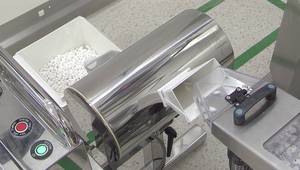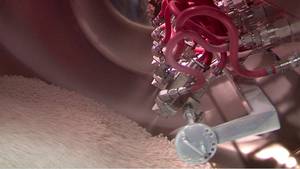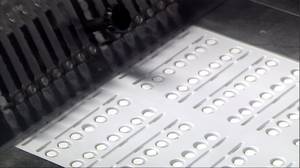Naked Engineering - Making Drugs
Interview with
Kat - So we've heard how drugs like aspirin can be used and maybe how they work, but how are they actually made? For this week's Naked Engineering, Meera and Dave have been on a road trip to look at GlaxoSmithKline's tablet manufacturing site in Ware, Hertfordshire. Director of Innovation, Andy Robertson, showed them around...
Andy - At Ware we make a wide range of drugs. We make drugs that people will recognise for the disease they treat. We make drugs for HIV and AIDS. We also do a lot of drugs for cancer. So we have a wide range of products with a wide range of applications.
Meera - So, from the beginning, how are tablets made?
Andy - Well this site at Ware is what we call a secondary process site. So what we do is we bring in raw materials, active ingredients, and we have to measure them out in the same and correct ratios to form the tablet.
Dave - So I guess if you've got lots of different ingredients in there, they must have different jobs.
Andy - What goes into the tablet really depends on the product and each of the things going into the tablet have a different function. For example, you might require to put a bulking agent in there, so if the active ingredient is strong, there wouldn't be enough to create a tablet. So you need a bulking agent to actually form the tablet. The other thing that you might need is a binder to bind the powders together, as well as a disintegrant...
going into the tablet have a different function. For example, you might require to put a bulking agent in there, so if the active ingredient is strong, there wouldn't be enough to create a tablet. So you need a bulking agent to actually form the tablet. The other thing that you might need is a binder to bind the powders together, as well as a disintegrant...
Dave - ...To help you absorb it once it's in your stomach or whatever, to let the tablet fall apart and ensure it is absorbed quick enough.
Meera - Once this is all together, what next?
Andy - Well obviously, when they've been put all together in the correct ratio, we have to blend them to make sure they're all well-mixed so the blend becomes homogenised.
Dave - I guess this is a really critical step because if it's badly mixed, you might get one tablet which is all filler and another tablet which is all active ingredient.
Andy - Absolutely.
Meera - But what kind of scales are we talking about here? We're in one of your control rooms now and I can look out onto one of these large mixing bins. It's a meter wide and a meter high, so it's quite big.
Andy - Those bins hold up to 400 kilos, just put in context, those 400 kilo bins, can make up to 800,000 tablets.
---
Meera - One possible next step having mixed together the ingredients is granulation. So we're now in a large granulation room, standing by what looks like a hole in the ceiling, out of which the ingredients actually drop into this processor.
Andy - It is a bit like a food processor, so what you do is you put the contents of the bin into this food processor to change the properties of the material. So you're creating a granule and you're having to use a binding agent, and water.
 Dave - So instead of having a mixture of several different powders, you now have a load of granules. Each one is made up of all your different powders. This must stop the powders separating out in later parts of the process.
Dave - So instead of having a mixture of several different powders, you now have a load of granules. Each one is made up of all your different powders. This must stop the powders separating out in later parts of the process.
Andy - Absolutely, right. That's one of the main reasons for doing it. This machine makes granules and it discharges the granules through a wet mill and the purpose of the wet mill is to chop them up into very small bits again before it drops into a fluid bed dryer, and the fluid bed dryer, you can see it's 4 meters high. It's around a meter and a half in diameter. What that then does, it fluidises its powder by passing air through it continuously. This is aiming to dry off excess water out of the granule, but not too much that it becomes a powder again.
Meera - Coming out of the bottom then I imagine is the perfect formulation to then make a tablet.
Andy - It's nearly ready to be made into a tablet. Before we put it into a compression machine to make tablets, we add a lubrication substance called mag stearate (magnesium stearate). This allows the tablet to be pressed out of the tablet after forming without breaking it.
---
Meera - Now having gotten everything together, ingredients of the right consistency, it's now time to make tablets!
Andy - Yes, this tablet press you see in front of us here is making around 40,000 tablets an hour.
Meera - I'm not surprised that it's making so many because it's a cylinder whizzing around now and I can just see hundreds of tablets in the past minute that we've been here.
Andy - The way the tablet press works is a rotary die which is a plate with loads of holes in it, with two punches; top and bottom punches. So, as the plate goes around, the powder fills up all the holes and the punches then compress it into a tablet and then punch those tablets out.
Dave - And you're measuring how much powder you've got in there by basically, if it fills up the plate then that's going to be a consistent volume every time.
Andy - That's right.
 Meera - So now, we have tablets and they've been checked if they are correct, but what next between here and actually sending them out?
Meera - So now, we have tablets and they've been checked if they are correct, but what next between here and actually sending them out?
Andy - What we do before the tablets leave this facility is to coat the tablets in the coating machine. The coating process is rather like a tumble dryer where we're spraying liquid onto them and coating them slowly. Part of the reason for coating the tablet is to protect the ingredients from the environment, for example. It could also be masking any unpleasant taste when the patient takes the tablet, ease of swallowing the tablet, and it can even be used for improving the mechanical strength of the tablet.
Dave - I guess you can affect how it's dissolved so you put a coating on there which isn't dissolved in the acidic conditions of your stomach, so it can get through to the small intestine.
Andy - That's exactly right and after the coating process, the next step after that is actually the packaging process. So they can either be packed in what we call blister packs but they also can be packed into bottles.
Meera - We've now moved away from the actual manufacturing area on this site, but we've seen the ingredients being mixed, tablets being formed and coated, but Andy, how, throughout this process, are the tablets tested to make sure that they're all actually the same and uniform?
Andy - The quality assurance of the product is that each of the unit operations are fully understood and known, and all the critical parameters are monitored through the process. During each of those stages, samples are taken and insured the various test parameters are achieved. Such as, at the tablet press stage, we take the samples out and test for hardness, test for thickness, test for dissolution. As a result, we know that the quality of the product is good at all point in time.










Comments
Add a comment